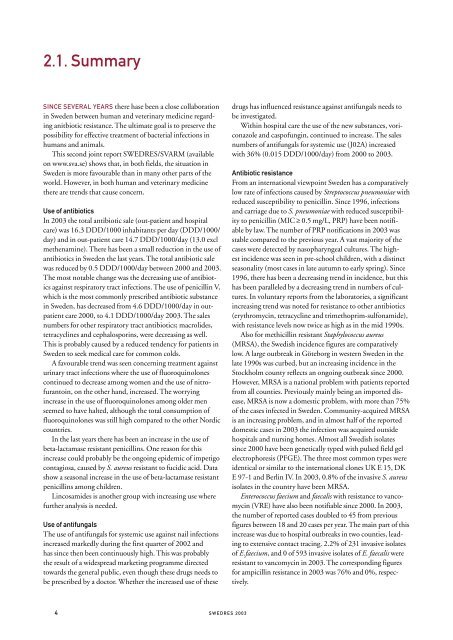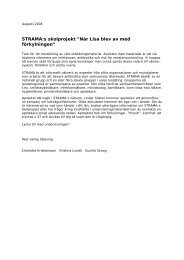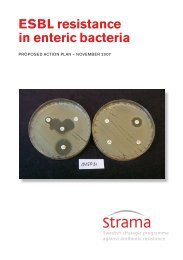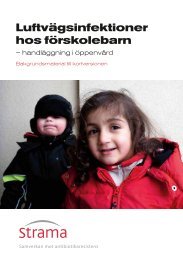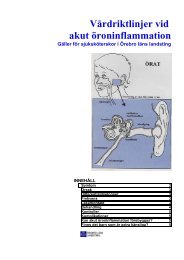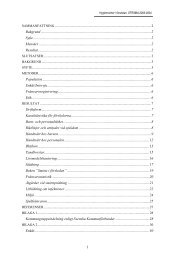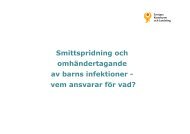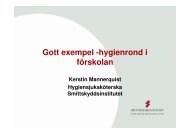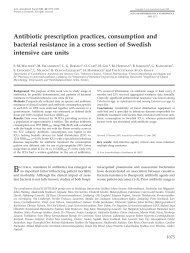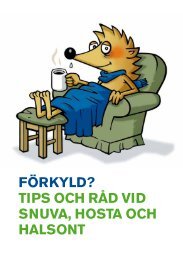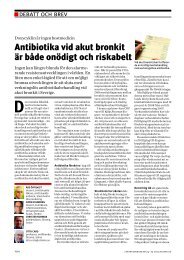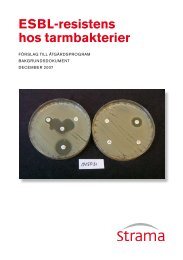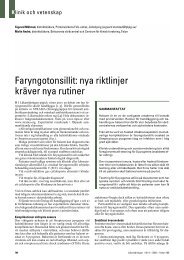Link - Snowfall
Link - Snowfall
Link - Snowfall
Create successful ePaper yourself
Turn your PDF publications into a flip-book with our unique Google optimized e-Paper software.
2.1. SummarySINCE SEVERAL YEARS there hase been a close collaborationin Sweden between human and veterinary medicine regardinganitbiotic resistance. The ultimate goal is to preserve thepossibility for effective treatment of bacterial infections inhumans and animals.This second joint report SWEDRES/SVARM (availableon www.sva.se) shows that, in both fields, the situation inSweden is more favourable than in many other parts of theworld. However, in both human and veterinary medicinethere are trends that cause concern.Use of antibioticsIn 2003 the total antibiotic sale (out-patient and hospitalcare) was 16.3 DDD/1000 inhabitants per day (DDD/1000/day) and in out-patient care 14.7 DDD/1000/day (13.0 exclmethenamine). There has been a small reduction in the use ofantibiotics in Sweden the last years. The total antibiotic salewas reduced by 0.5 DDD/1000/day between 2000 and 2003.The most notable change was the decreasing use of antibioticsagainst respiratory tract infections. The use of penicillin V,which is the most commonly prescribed antibiotic substancein Sweden, has decreased from 4.6 DDD/1000/day in outpatientcare 2000, to 4.1 DDD/1000/day 2003. The salesnumbers for other respiratory tract antibiotics; macrolides,tetracyclines and cephalosporins, were decreasing as well.This is probably caused by a reduced tendency for patients inSweden to seek medical care for common colds.A favourable trend was seen concerning treatment againsturinary tract infections where the use of fluoroquinolonescontinued to decrease among women and the use of nitrofurantoin,on the other hand, increased. The worryingincrease in the use of fluoroquinolones among older menseemed to have halted, although the total consumption offluoroquinolones was still high compared to the other Nordiccountries.In the last years there has been an increase in the use ofbeta-lactamase resistant penicillins. One reason for thisincrease could probably be the ongoing epidemic of impetigocontagiosa, caused by S. aureus resistant to fucidic acid. Datashow a seasonal increase in the use of beta-lactamase resistantpenicillins among children.Lincosamides is another group with increasing use wherefurther analysis is needed.Use of antifungalsThe use of antifungals for systemic use against nail infectionsincreased markedly during the first quarter of 2002 andhas since then been continuously high. This was probablythe result of a widespread marketing programme directedtowards the general public, even though these drugs needs tobe prescribed by a doctor. Whether the increased use of thesedrugs has influenced resistance against antifungals needs tobe investigated.Within hospital care the use of the new substances, voriconazoleand caspofungin, continued to increase. The salesnumbers of antifungals for systemic use (J02A) increasedwith 36% (0.015 DDD/1000/day) from 2000 to 2003.Antibiotic resistanceFrom an international viewpoint Sweden has a comparativelylow rate of infections caused by Streptococcus pneumoniae withreduced susceptibility to penicillin. Since 1996, infectionsand carriage due to S. pneumoniae with reduced susceptibilityto penicillin (MIC ≥ 0.5 mg/L, PRP) have been notifiableby law. The number of PRP notifications in 2003 wasstable compared to the previous year. A vast majority of thecases were detected by nasopharyngeal cultures. The highestincidence was seen in pre-school children, with a distinctseasonality (most cases in late autumn to early spring). Since1996, there has been a decreasing trend in incidence, but thishas been paralleled by a decreasing trend in numbers of cultures.In voluntary reports from the laboratories, a significantincreasing trend was noted for resistance to other antibiotics(erythromycin, tetracycline and trimethoprim-sulfonamide),with resistance levels now twice as high as in the mid 1990s.Also for methicillin resistant Staphylococcus aureus(MRSA), the Swedish incidence figures are comparativelylow. A large outbreak in Göteborg in western Sweden in thelate 1990s was curbed, but an increasing incidence in theStockholm county reflects an ongoing outbreak since 2000.However, MRSA is a national problem with patients reportedfrom all counties. Previously mainly being an imported disease,MRSA is now a domestic problem, with more than 75%of the cases infected in Sweden. Community-acquired MRSAis an increasing problem, and in almost half of the reporteddomestic cases in 2003 the infection was acquired outsidehospitals and nursing homes. Almost all Swedish isolatessince 2000 have been genetically typed with pulsed field gelelectrophoresis (PFGE). The three most common types wereidentical or similar to the international clones UK E 15, DKE 97-1 and Berlin IV. In 2003, 0.8% of the invasive S. aureusisolates in the country have been MRSA.Enterococcus faecium and faecalis with resistance to vancomycin(VRE) have also been notifiable since 2000. In 2003,the number of reported cases doubled to 45 from previousfigures between 18 and 20 cases per year. The main part of thisincrease was due to hospital outbreaks in two counties, leadingto extensive contact tracing. 2.2% of 231 invasive isolatesof E.faecium, and 0 of 593 invasive isolates of E. faecalis wereresistant to vancomycin in 2003. The corresponding figuresfor ampicillin resistance in 2003 was 76% and 0%, respectively.4 S W E D R E S 2 0 0 3


